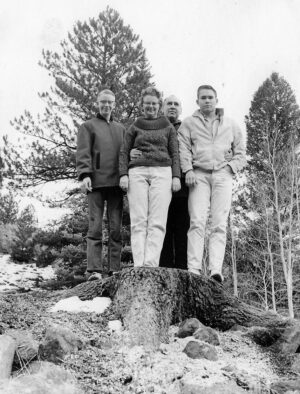by John Orr
2010 Colorado legislative session
Gunnison County’s State Representative Kathleen Curry — who recently declared as an independent after winning her seat in the state house as a Democrat — plans to introduce a bill that would allow rafting companies and others to float through private property without being subject to trespassing charges from landowners. Her bill would clear up the current ambiguity in state statutes. According to the Colorado Independent the bill would “allow licensed outfitters to not only raft, kayak or fish on rivers and streams crossing private property, but also make contact with the riverbank without trespassing.” Outfitters would be limited to incidental contact and portaging necessary for safety reasons — say to portage around a bridge during high water. Meal stops or bathroom breaks would still be trespassing.
Curry’s concerns stem from the closure of a stretch of the Taylor River that had been historically open to two rafting companies in the valley. Last summer a new landowner bought a parcel bisected by the river and informed the outfitters that the area would now be off limits.
As most Central Coloradans know rafting, fishing and whitewater sports are big business and big employers on both sides of the Sawatch Range. The “backbone of the continent” gives rise to the headwaters of the Arkansas, Gunnison, Roaring Fork and Eagle rivers, and recreation opportunities abound on tributaries like the Taylor River. According to Bob Hamel, president of the Colorado River Outfitters Association, rafting is a $142 million business in Colorado.
Jobs and local economies are the target of another piece of proposed legislation that the sponsor hopes will slow that pace of drying up farms to water Colorado’s Front Range cities and unbridled municipal growth.
State Representative Sal Pace hopes to finally get state water court judges to be required to set mitigation of the economic and ecological effects to originating communities when water is moved out of basin. The existing law that deals with mitigation of transbasin diversions — the 1937 Conservancy District Act — only applies to diversions from the west slope to the east slope. Pace’s bill would extend that protection to all transfers.
Mitigation examples include cash payments to or infrastructure improvements in the originating basin such as a reservoir to store water for times of scarcity. Wolford Mountain Reservoir in Grand County is a good example. The 66,000 acre-foot reservoir is owned by the Colorado River District. Denver Water can use 40 percent of Wolford’s water and the remaining water can be contracted by the district for use by western slope interests.
2010 water year
It’s the time of the year where farmers, water providers, irrigators, hydroelectric generators, whitewater enthusiasts and many others keep one eye on the sky. The 2010 water year started on November 1 with snowpack looking OK. Then came December and early January and low precipitation across the state. Snowpack has generally declined and as we go to press Colorado is sitting at 78% of average. The Arkansas Basin is at 81%, the Rio Grande and South Platte basins are showing 83%, while the Gunnison comes in at 80%. Half of the snow season remains, so make sure to do a rain dance or two over the next few weeks.
Don’t forget that most of Colorado was “abnormally dry” according to the U.S. Drought Monitor website (http://drought.unl.edu/DM/MONITOR.html) through the end of March last year. We had a wet spring and early summer that allowed everybody fill their storage and a pretty good water year overall.
The Natural Resources Conservation Service, the federal agency that works with each state to track snowpack and forecast stream flows, released its first stream forecast of the season for Colorado on January 8. Forecasts for runoff for Central Colorado streams ranged from near average to slightly below average as of January 1. That may change after January snowfall is factored in. Readers can track the data for themselves by surfing the Colorado NRCS website at http://www.co.nrcs.usda.gov/snow.
California Gulch and Summitville
Grupo Mexico bought the assets of ASARCO LLC and inherited the mining and smelting company’s Superfund obligations. In December, Grupo Mexico ponied up $1.79 billion to resolve ASARCO’s environmental liabilities. Colorado’s portion of the total is $42 million and some of the dough is earmarked for the California Gulch Superfund site at Leadville and the Summitville Mine Superfund site on the Wightman Fork of the Alamosa River.
California Gulch was also in the news recently as the Environmental Protection Agency announced that they were looking to revamp some of the plan to clean up and restore the area. Back in the day when the EPA first started planning the cleanup there was a conflict with Lake County officials over what to do with the tailings piles left over from Leadville’s mining heyday. The tailings were and continue to be a major source of acid mine drainage. Those who wanted to preserve the look and feel of mining to enhance tourism in Leadville opposed capping or removing the tailings. At the time the EPA was said to be “incredulous” towards those that proposed preservation. The EPA relented, and managing the tailings has proved problematical to this day.
Late last year the EPA showed off a pilot study where they sprayed shotcrete on tailings, coloring the shotcrete to resemble the original piles. According to the Leadville Herald Democrat, “The reaction to the work was positive, with comments about how authentic the piles still looked.”
The pilot study includes two areas, one with a liner and one without. The EPA plans to monitor groundwater in the area to test the efficacy of the pilot.
Short takes
• Colorado’s population topped 5 million in July 2009, according to estimates from the U.S. Census Bureau.
• Denver Water closed off public access to Cheesman Reservoir on January 1st. They plan to upgrade the dam’s valve system, which was installed when the dam was built in 1905. It was last upgraded in the late 1920s. They’re also planning to install underwater trash racks to prevent debris from clogging the valves. Plans call for reopening the reservoir on May 1, 2011.
• Keep on buying Lotto tickets. You might win, and Great Outdoors Colorado can keep funding cool outdoor projects like the new whitewater park on the Arkansas River in Cañon City. GOCo is kicking in $25,000.
• Late in November the Center for Biological Diversity filed a lawsuit over the 2007 decision that kept the Colorado River cutthroat trout off the endangered species list. The cutthroats are missing in action from 87% of their historic range.
• Happy 40th birthday to the National Environmental Policy Act. President Nixon signed NEPA into law on January 1, 1970.
• Say adios to Governor Bill Ritter. He’ll be a one-termer after announcing that he was choosing family over a rotten budget, huge infrastructure investment requirements, water supply questions, etc.
John Orr follows Colorado Water issues at Coyote Gulch http://coyotegulch.net


